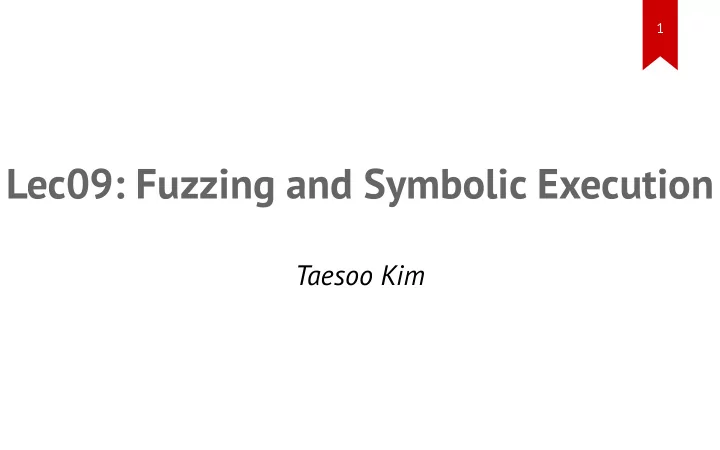

1 Lec09: Fuzzing and Symbolic Execution Taesoo Kim
2 Administrivia • Three more labs! including NSA code-breaking challenge! • Please submit your working “exploits” for previous weeks! • New recitations: • Monday: 18:00~19:00, CoC 053 (Oct 29th: S106 Howney Physics) • Wednesday: 18:00~19:00, CoC 052 • In-class CTF on Nov 16-17 (24 hours)! • Due: Find your team members, and let us know ASAP! • Due: Submit your CTF challenge by Nov 13!
3 So far, focuses are more on “exploitation” • More important question: how to find bugs? • With source code (we will see in the last lecture!) • With only binary
4 Two Pre-conditions (often much difficult!) 1. Locating a bug (i.e., bug finding) 2. Triggering the bug (i.e., reachability) 1 // Q2. How to reach this path? 2 if (magic == 0xdeadbeef) { 3 // Q1. Is this buggy? 4 memcpy(dst, src, len) 5 }
5 Solution 1: Code Auditing (w/ code) 1 static OSStatus SSLVerifySignedServerKeyExchange(...) { 2 ... 3 if (err = SSLHashSHA1.update(&hashCtx, &clientRandom)) 4 goto fail; 5 if (err = SSLHashSHA1.update(&hashCtx, &serverRandom)) 6 goto fail; 7 if (err = SSLHashSHA1.update(&hashCtx, &signedParams)) 8 goto fail; 9 goto fail; 10 if (err = SSLHashSHA1.final(&hashCtx, &hashOut) 11 goto fail; 12 13 err = sslRawVerify(...); 14 fail: 15 return err; 16 }
6 Solution 2: Static Analysis (on binary) • Reverse Engineering (e.g., IDA)
7 Problem: Too Complex (e.g., browser)
8 Two Popular Directions • Symbolic execution (also static) • Fuzzing (dynamic)
9 Symbolic Execution
10 Problem: State Explosion • Too many path to explore (e.g., strcmp(“hello”, input)) • Too huge state space (e.g., browser? OS?) • Solving constraints is a hard problem
11 Today’s Topic: Fuzzing • Two key ideas • Reachability is given (since we are executing!) • Focus on quickly exploring the path/state • How? mutating inputs • How/what to mutate? based on code coverage!
12 How well fuzzing can explore all paths? 1 int foo(int i1, int i2) { 2 int x = i1; 3 int y = i2; 4 5 if (x > 80) { 6 x = y * 2; 7 y = 0; 8 if (x == 256) { 9 * __builtin_trap(); 10 return 1; 11 } 12 } else { 13 x = 0; y = 0; 14 } 15 return 0; 16 }
13 DEMO: LibFuzzer // $ clang -fsanitize=fuzzer ex.cc // $ ./a.out extern "C" int LLVMFuzzerTestOneInput(const uint8_t *data, size_t size) { if (size < 8) return 0; int i1, i2; i1 = *(int *)(&data[0]); i2 = *(int *)(&data[4]); foo(i1, i2); return 0; }
14 Game Changing Fact: Speed • In this example, • Symbolic execution explores/checks just two conditions • Fuzzing requires 256 times (by scanning values from 0 to 256) • What if fuzzer is an order of magnitude faster (say, 10k times)? • In fact, LibFuzzer was much faster thanks to lots of heuristics!
15 Importance of High-quality Corpus • In fact, fuzzing is really bad at exploring paths • e.g., if (a == 0xdeadbeef) • So, paths should be (or mostly) given by corpus (sample inputs) • e.g., pdf files utilizing full features • but, not too many! (do not compromise your performance) • A fuzzer will trigger the exploitable state • e.g., len in malloc()
16 AFL (American Fuzzy Lop) • VERY well-engineered fuzzer w/ lots of heuristics
17 Examples of Mutation Techniques • interest: -1, 0x8000000, 0xffff, etc • bitflip: flipping 1,2,3,4,8,16,32 bits • havoc: random tweak in fixed length • extra: dictionary, etc • etc
18 Key Idea 1: Map Input to State Transitions • Input → [IPs] (problem?)
19 Key Idea 1: Map Input to State Transitions • Input → [IPs] (problem?) • Input → map[IPs % len] (problem? A → B vs B → A)
20 Key Idea 1: Map Input to State Transitions • Input → [IPs] (problem?) • Input → map[IPs % len] (problem? A → B vs B → A) • Input → map[(prevIP >> 1 ^ curIP) % len] (problem?)
21 Key Idea 1: Map Input to State Transitions • Input → [IPs] (problem?) • Input → map[IPs % len] (problem? A → B vs B → A) • Input → map[(prevIP >> 1 ^ curIP) % len] (problem?) • Input → map[(rand1 >> 1 ^ rand2) % len]
22 Key Idea 2: Avoiding Redundant Paths • If you see the duplicated state, throw out • e.g., i1 = 1, 2, 3 • If you see the new path, keep it for further exploration • e.g., i1 = 81
23 How to Create Mapping? • Instrumentation • Source code → compiler (e.g., gcc, clang) • Binary → QEMU 1 if (block_address > elf_text_start 2 && block_address < elf_text_end) { 3 cur_location = (block_address >> 4) ^ (block_address << 8) 4 shared_mem[cur_location ^ prev_location] ++; 5 prev_location = cur_location >> 1; 6 }
24 Source Code Instrumentation
25 AFL Arts Ref. http://lcamtuf.coredump.cx/afl/
26 Other Types of Fuzzer • Radamsa: syntax-aware fuzzer • Cross-fuzz: function syntax for Javascript • langfuzz: fuzzing program languages • Driller/QSYM: fuzzing + symbolic execution
27 Today’s Tutorial • In-class tutorial: • Fuzzing with AFL • Fuzzing with LibFuzzer $ scp -P 9007 lab07@computron.gtisc.gatech.edu:fuzzing.tar.xz . $ unxz fuzzing.tar.xz $ docker load -i fuzzing.tar $ docker run --privileged -it fuzzing /bin/bash $ git pull $ cat README
28 References -Sanitize, Fuzz, and Harden Your C++ Code
Recommend
More recommend